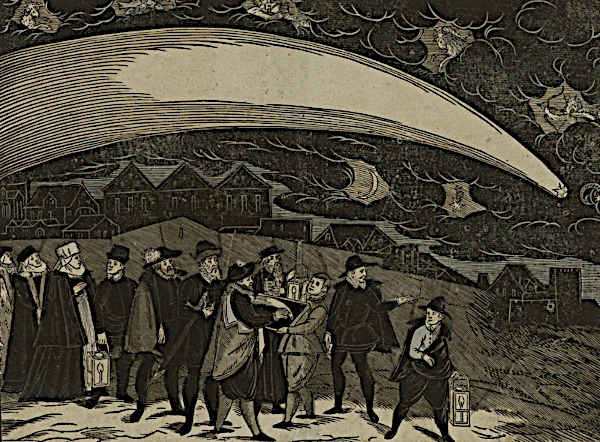
Image: Representation of the great comet of 1577. Five zodiac symbols appear above the comet (Aries, Pisces, Aquarius, Capricorn and Sagittarius). Below the comet's tail are the crescent moon and Saturn represented as a star. Credit: This image is in the public domain.
The great comet of 1577 or "Tycho Brahe's Comet" is one of the most famous comets in the history of astronomy.
Various observers have noted its intense brightness and long tail. The comet was as bright as the Moon and its tail occupied about sixty degrees in the sky (120 times the diameter of the Moon). It first appeared in November 1577 and remained visible to the naked eye until March 1578.
The comet's trajectory was measured with great precision by the Danish astronomer Tycho Brahe (1546-1601). These observations allowed Tycho Brahe to understand that comets were celestial objects clearly located beyond the Moon. This revolutionary observation thus contradicted the common belief of the time according to which comets were atmospheric phenomena.
Additionally, the 1577 comet followed a parabolic path around the Sun, entered the solar system at high speed, made a close pass near the Sun, and then returned outward. Observations of the comet provided further evidence for the validity of Copernicus' (1473–1543) heliocentric model.
The other impact of the 1577 comet was the abandonment of the concept of crystal spheres. Indeed, the widely accepted model of Ptolemy (ca. 100-168) held that the planets were fixed on crystal spheres which themselves revolved around the Earth.
But Tycho Brahe's careful observations showed that the comet passed through the supposed spheres of the planets without being deviated from its path. This directly contradicted this concept.
In Copernicus' heliocentric model, which placed the Sun at the center of the solar system, there was no need for crystal spheres to explain the movements of the planets. However, as in Ptolemy's model, Copernicus' model retained the circular trajectories of the planets.
Finally, Tycho Brahe's observations allowed Johannes Kepler (1571-1630) to demonstrate that the planets followed elliptical orbits around the Sun and not circular ones. Kepler's model matched astronomical observations better. This model accurately explained the movements of the planets, including their variations in speed and distance from the Sun.
In summary, the detailed observation of the great comet of 1577 revolutionized scientific thinking of the time. From then on, the models, more in agreement with observations of the sky, laid the foundations of celestial mechanics.
note: The orbital period of the 1577 comet has not been determined because it did not return after its passage in 1578. It is a non-periodic comet, which means that it followed a parabolic or hyperbolic trajectory and probably left the solar system after its passage.